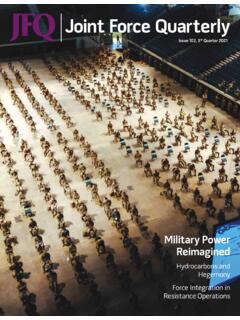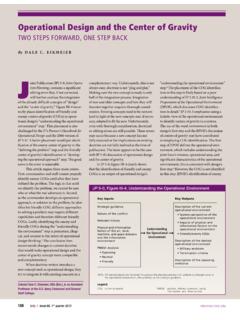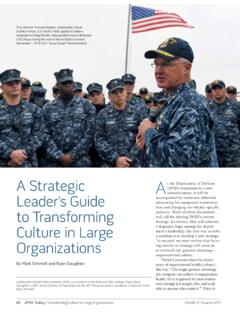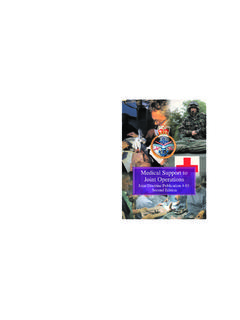Transcription of The Role of Multinational Joint Doctrine
1 Issue 67, 4th quarter 2012 / JFQ 111 The nature of the challenges to the United States and its interests demand that the Armed Forces operate as a Joint team, closely integrated with inter-organizational and Multinational partners across the range of military operations. Joint Publication 1, Doctrine for the Armed Forces of the United StatesThe purpose of Joint Doctrine is to enhance the operational effective-ness of forces. It represents what is taught, believed, and advocated as what is right (that is, what works best). It also provides the national position for Multinational Doctrine and serves as a basis for Multinational or interagency coordination during Joint forces operate as part of a Multinational force, they follow Multinational Joint Doctrine and procedures to the extent that the guidance is consistent with law and policy.
2 Joint Publication 1-02, Department of Defense Dictionary of Military and Associ-ated Terms, defines Multinational Doctrine as Fundamental principles that guide the employment of forces of two or more nations in coordinated action toward a common objective. Multinational Doctrine enhances the interoperability of coalition forces and provides fundamental considerations used to determine command relationships and the assignment of missions, objectives, and tasks. In all cases, Multinational Doctrine must be well known, universally accepted, and com-monly understood to be Joint Doctrine Framework Within the North Atlantic Treaty Orga-nization (NATO), allied Joint Doctrine (AJD) provides the operational framework for operations conducted by Alliance members and partners, non-NATO nations, and other organizations.
3 NATO policy guides AJD development by providing the baseline for the doctrinal principles or fundamentals. NATO s policy and Doctrine developers strive to closely coordinate their efforts, ensuring that the relationship between NATO policy and military Doctrine is consistent and mutually s Doctrine is aligned within the AJD Architecture (AJDA). The AJDA is com-prised of allied Joint Publications (AJP) and supporting allied Publications (AP). There are currently 45 approved AJPs and four APs in the AJD portfolio. The majority of AJPs (28) reside in the Operations is organized into two levels. Level-one publications contain overarch-ing Doctrine , namely, NATO s capstone publication, AJP-01, allied Joint Doctrine , as well as keystone publications AJP-2, AJD for Intelligence, Counter-Intel, and Security; AJP-3, AJD for the Conduct of Operations; AJP-4, allied Joint Logistics Doctrine ; AJP-5, AJD for Operational-level Planning; and AJP-6, AJD for Communication and Infor-mation Systems.
4 Level-two publications contain supporting Joint Doctrine aligned to specific functional Joint Doctrine Development Current AJDA has more than doubled since 2005, expanding to include topics across the spectrum of military operations that now include , Intelligence Pro-cedures; , Joint ISR; , Force Protection; , Air and Space Opera-tions; , Civil-Military Cooperation; , Psychological Operations; , Special Operations; , allied Joint Logistics; , Host Nation Support; AJP-5, Operational Level Planning; and AJP-6, Computers and Information Systems. Six of the 28 member nations serve as AJD custodians, which is not to say that only six nations are contributing. Virtually every custodian team and working group includes contributions from all 28 member nations.
5 Since 2009, NATO approved or will soon promulgate 10 new Joint publications, among them Doctrine for military support to stability and reconstruction, counter-intelligence, and counterinsurgency. Additionally, AJD devel-opment is under way for geospatial intelli-gence and stability policing. The AJP-2 series, currently consisting of six AJPs, is potentially expanding to include Doctrine on signals The Role of Multinational Joint Doctrine By The Joint ChIeFs OF sTAFF J7 Joint eDUCATION AND Doctrine DIVIsIONJOINT Doctrine | Updateintelligence, imagery intelligence, measure-ment and signature intelligence, open-source intelligence, and collection coordination and intelligence requirements for the development, management, and standardization of AJD lies with the allied Joint Operations Doctrine Working Group (AJODWG).
6 The primary mission of the AJODWG is to enhance the interoperability and thus the effectiveness of NATO forces when planning and conduct-ing Joint operations through the provision of AJD, with the emphasis on Doctrine at the operational level. The AJODWG consists of delegates from NATO member nations, the International Military Staff, and the two strategic commands ( allied Command Trans-formation and allied Command Operations). The AJODWG has many responsibilities; however, its principal roll is to ensure that AJD conforms to NATO policy and guidance. The working group reviews proposals that identify doctrinal voids and recommends Doctrine development to fill those voids. Additionally, the group ensures that AJD content is stan-dardized in terms of layout, presentation, and format.
7 The AJODWG is also responsible for harmonizing the AJDA ensuring coherence and consistency with NATO policy across the level one keystone and capstone publications as well as vertically between the level-one and level-two AJODWG meets in March and September annually at NATO Headquarters to review the AJDA to determine continued validity and, where necessary, recommend revision, consolidation, or cancellation of AJPs. In addition, the AJODWG identifies doctrinal voids, identifies and develops new Doctrine proposals, and reviews lessons learned from recent operations, exercises, and experimentation for their potential for new or amended Doctrine proposals to enhance , the AJODWG is managing a number of Doctrine initiatives.
8 First, , allied Joint Doctrine for Non Article 5 Crisis Response Operations, is being reviewed as a potential thematic Doctrine for series publications (Stability and Reconstruction, Counterinsurgency, Peace Support, Non-Com-batant Evacuation, Military Support to Civil Authorities, Civil Military Cooperation, and Stability Policing). Second, while security force assistance (SFA) remains a relatively immature topic in NATO, there exists the potential for developing SFA Doctrine . Third, recent and anticipated NATO policy changes will inform the eventual revision of AJP-01 and AJP-3, AJD for the Conduct of Operations. The AJODWG will address recent policy devel-opments on environmental protection, the Comprehensive Approach (NATO s response to crisis management involving political, civil, and military instruments of power), and strategic communication, and include lessons learned from operations in Libya.
9 Finally, AJP-5, AJD for Operational Level Planning, was drafted and is awaiting member nations ratification and should be approved as formal Doctrine by this Role in AJD The Joint Staff J7 leads the effort in providing the military s position on warfighting guidance to all the Alliance nations. The Chief of J7 s Joint Education and Doctrine Division (JEDD) serves as the Head of Delegation (HOD) to the AJODWG. The HOD represents the Chairman and J7 within the Multinational AJOD forum, responsible for expressing the official position of the United States and ensuring that roles , extant capabilities, and warfighting philosophy are accurately represented throughout the AJDA.
10 In this capacity, the HOD approves ratification responses for AJPs and reviews emerging Multinational Doctrine publications for consistency with law, regulations, and approved and emerging Joint publications. Additionally, the United States serves as cus-todian, or author, of 10 AJPs and 1 AP, Joint Symbology. By taking ownership of 11 of the 49 publications in the AJDA, the United States continues its enduring commitment to further develop of NATO s AJD portfolio. Most noteworthy among AJD development is , allied Joint Doctrine for Mili-tary Support to Stability and Reconstruction (S&R), which is expected to be approved this fall. It defines planning considerations in the event that NATO provides S&R support until the relevant nonmilitary authorities are able to assume the duty.



















